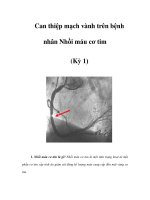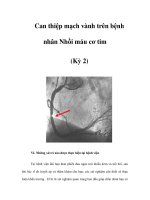Tiếp cận can thiệp mạch vành ở người bệnh suy tim
Bạn đang xem bản rút gọn của tài liệu. Xem và tải ngay bản đầy đủ của tài liệu tại đây (2.81 MB, 38 trang )
14th Vietnam National Congress of Cardiology
Da Nang City Vietnam 2014
PCI In Heart Failure
Dr Tan Huay Cheem
MBBS, M Med(Int Med) MRCP(UK), FRCP(Edinburgh), FAMS, FACC, FSCAI
Director, National University Heart Centre, Singapore
Associate Professor of Medicine, Yong Loo Lin School of Medicine
National University of Singapore
President, Asia Pacific Society of Interventional Cardiology
National University Heart Centre, Singapore
(NUHCS)
Case Study
M/46 CVRF smoking. Admitted for NSTEMI. 2D echo showed LVEF 20%
Case Study
Case Study
Case Study
Two-Dimensional Echocardiogram Pre-& Post-PCI
Pre-PCI
3 Months Pre-PCI
LVEF improved from visual estimate 20% to 40%
Myocardial Revascularisation In Chronic Heart Failure
• Coronary artery disease remains the most common cause of CHF
• Patients with depressed LV function remain ar risk of sudden cardiac death
with or without revascularisation
• Revascularisation with CABG or PCI is indicated for symptomatic relief
of angina pectoris in patients with heart failure
• The risk-benefit balance for revascularization in patients without
angina/ischemia or viable myocardium remains uncertain
PCI In Heart Failure
• PCI in Heart Failure (Balloon to DES)
- feasibility and safety
• PCI in Heart Failure with Support
• PCI vs CABG vs Medical Therapy
Impact of LV Dysfunction on Hospital Mortality
Among Patients Undergoing Elective PCI: New York State Registry
Retrospective study of 55 709 PCI pts in 1998/1999
≤25%
26-35%
36-45%
46-55%
>55%
Procedure
3.4%
7.6%
17.4%
34.4%
37.2%
Hospital Mortality
2.7%
1.2%
0.6%
0.2%
0.3%
P<0.001
Conclusions
• Elective PCI is commonly performed in pts with reduced EFs
• Risk for hospital mortality increases as the EF decreases
• EF 45% is associated with higher adjusted hospital mortality
Wallace TW et al Am J Cardiol 2009; 103: 355-360
GRACE Registry: PCI In ACS Pts with Heart Failure
• 1788 had HF at the time of hospital admission
• Patients with HF less likely to undergo cardiac cath
(46.5% vs 54.2%, p=0.0001) and PCI (26% vs 31.8%, p=0.0001)
compared with pts without HF
• CABG rates similar between groups
• Combined risk of in-hospital and post-discharge 6-month mortality
was significantly higher in pts with HF on admission
(20.7% vs 5.9%, p<0.001)
• Pts with HF who underwent in-hospital revascularisation
(predominantly PCI) had significantly lower rate of
post-discharge 6-month mortality (14% vs 23.7%, P<0.0001)
Steg PG et al Circulation 2004; 109: 494-9
Impact of PCI On Acute Heart Failure Among Patients Hospitalised
For AMI: Long Term Outcomes by Killip Class
L Carvalho et al Singapore Cardiac Society Annual Meeting 2014
Impact of PCI On Acute Heart Failure Among Patients Hospitalised
For AMI: Long Term Outcomes
A1.00
B1.00
I
II
III
IV
0.75
Mortality, %
0.75
0.50
0.50
0.25
0.25
0.00
0.00
0
2
4
6
8
10
12
0
Time (years)
A.
B.
2
4
6
8
10
Time (years)
Mortality curves of patients who underwent PCI
Mortality curves of patients who did not undergo PCI
Killip I
Killip III
Killip II
Killip IV
L Carvalho et al Singapore Cardiac Society Annual Meeting 2014
12
PCI in Patients with Left Ventricular Systolic Dysfunction:
Systematic Review and Meta-Analysis
11 studies including 1284 pts with LVEF <50%. All except one study use BMS
MACE at hospital discharge
MACE at 18 mths followup
Conclusions:
• Low periprocedural morbidity and mortality following percutaneous
revascularisation
• Marked increase in event rate over follow-up, as expected in such high risk
patient population
GB Zoccai EuroInterv 2007; 3: 409-415
Outcomes of PCI Utilising DES in Pts with Reduced LVEF
• 5377 pts in Washington Heart Centre retrospectively analysed.
• Pts with normal LVEF (>50%) compared with mild (41% to 50%),
moderate (25% to 40%) and severe (<25%) decrease in LVEF
1 Yr All-cause Mortality
1 Yr Stent Thrombosis
• Pts with abnormal LVEF were older, more diabetic, renal insufficiency and
heart failure syndrome , more angiograpically complex lesions and less freq received DES
• Primary endpoint: 1-yr MACE all-cause death, Q-wave MI, ST and TLR
• Primary endpoint significantly increase in pt with lower LVEF (9.7% for normal LVEF
vs 20.6% for severely decreased LVEF, p<0.001)
• Higher ST in pts with lower LVEF (1.4% for normal LVEF vs 6% for
severely decrease LVEF, p<0.001), not impacted by DES use
Sardi GL et al Am J Cardiol 2012; 109: 344-351
Death Rates for Patients With and Without Myocardial Viability
Treated by Revascularization or Medical Therapy
HR Phillips et al Am Heart J 2007; 153: S65-S73
PCI In Heart Failure
• PCI in Heart Failure (Balloon to DES)
- feasibility and safety
• PCI in Heart Failure with Support
• PCI vs CABG vs Medical Therapy
BCIS-1 Trial: Elective IABP in High Risk PCI
• RCT in 17 UK tertiary centres bet Dec 2005 and Jan 2009
• 301 pts with severe LV dysfunction (EF <30%), extensive coronary disease
(jeopardy score ≥8/12)
Conclusions:
• Elective IABP did not reduce the incidence of MACCE at discharge
• Mortality at 6 months was numerically lower in the elective (IABP) group but
not statistically significant (4.6% vs 7.4%, P = 0.32)
Perera D et al JAMA 2010; 304: 867-874
TandemHeart Percutaneous VAD
• Removes oxygenated blood from LA via
transseptal cannula inserted through the
femoral vein
• Returns blood via femoral artery
Benefits:
• Reduce preload
• Reduce ventricular workload
• Reduce myocardial oxygen demand
• Increase MAP
• Improve microvascular and systemic
perfusion
IMPELLA Catheter
Mounted Micro Axial Flow Pump
Meyns B et al J Am Coll Cardiol 2003; 41: 1087-1095
Mechanical Circulatory Support in Cardiogenic Shock
Device
Ease of
Insertion
Duration of Use
Flow
L/min
Cost
Availability
IABP
+++++
DAYS TO
WEEKS
$
++++
IMPELLA
2.5
++++
HOURS TO
DAYS
2.2
$$
+
CPS
+++
HOURS
4-5
$$
+
+
WEEKS TO
MONTHS
5-6
$$$$$
+
REITAN
++++
HOURS TO
DAYS
2
?
_
PTVA
TandemHt
+++
DAYS TO
WEEKS
$$
+
LVAD
5.0
MetaAnalysis RCT of Percutaneous Left Ventricular Assist Devices
versus IABP for Treatment of Cardiogenic Shock
Thiele et al
Burkhoff et al
Seyfarth et al
LVAD
Control
TandemHeart
IABP
TandemHeart
IABP
Impella LP2.5
IABP
N of patients
Setting
Inclusion period
41
Single-center
2000-2003
33
Multi-center
2002-2004
26
Two-center
2004-2007
Randomization
Yes
Yes
Yes
JM Cheng et al CRT 2009
Results: 30-day Mortality
LVAD
n/N
IABP
n/N
Thiele et al.
9/21
9/20
0.95 (0.48 ; 1.90)
Burkhoff et al.
9/19
5/14
1.33 (0.57 ; 3.10)
Seyfarth et al.
6/13
6/13
1.00 (0.44 ; 2.29)
24/53
20/47
1.06 (0.68 ; 1.66)
Pooled
30-day mortality
Relative Risk
0.1
P(heterogeneity) = 0.83
I2 = 0%
1
Favors LVAD
10
Favors IABP
Percutaneous LVAD patients had similar mortality as IABP
JM Cheng et al CRT 2009
PCI In Heart Failure
• PCI in Heart Failure (Balloon to DES)
- feasibility and safety
• PCI in Heart Failure with Support
• PCI vs CABG vs Medical Therapy









